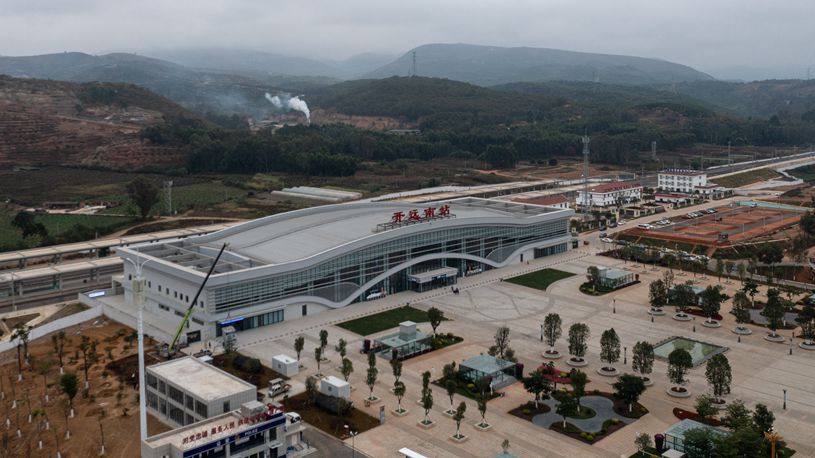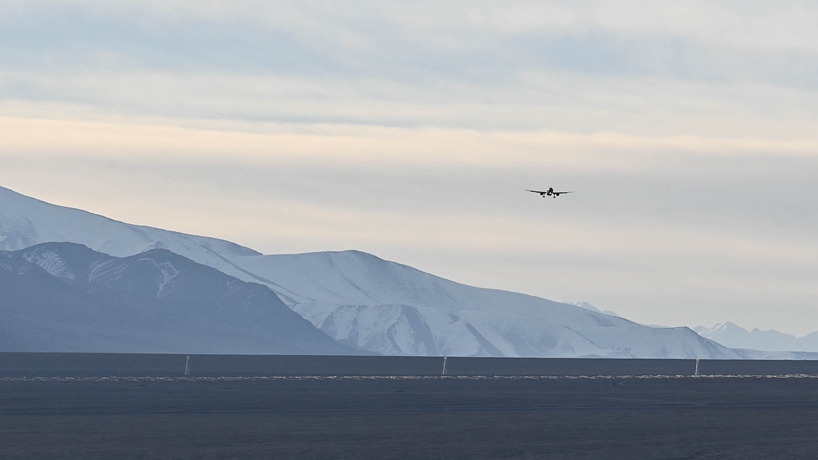
Aerial Photo taken on Dec. 8, 2022 shows the floating solar farm at the Sirindhorn dam in Ubon Ratchatani, Thailand. (Xinhua/Wang Teng)
With an average net energy output of nearly 90 million kwh per year, the hydro-floating solar project at the Sirindhorn Dam in northeastern Thailand has achieved its goal of providing low-cost, highly stable, eco-friendly energy, said an official.
BANGKOK, Dec. 24 (Xinhua) -- Natthamon, an amateur tourist guide, knows better that a green power plant can surely bring much more than green energy to her hometown in Thailand.
"During the peak of Songkran Festival, the site received 5,000 to 6,000 visitors per day," said Natthamon, a local girl working at the newly built Sirindhorn dam attraction.
The 24-year-old, who has worked here since it opened, guides visiting tourists through the function and construction process of the floating solar farm.
In December, the sun still shines brightly in Thailand. Looking out from the shore, a vast array of solar panels, floating on the reservoir, are working non-stop to convert sunlight into clean electricity for thousands of households in the country.
Just as the Electricity Generating Authority of Thailand (EGAT) envisioned initially, the hydro-floating solar project, located in the Sirindhorn Dam in northeastern Thailand, has now become a popular tourist spot with an exhibition center and a 400-meter-long "Nature Walkway", where visitors can enjoy the dam scenery and view of the floating panels.

Aerial Photo taken on Dec. 8, 2022 shows the floating solar farm at the Sirindhorn dam in Ubon Ratchatani, Thailand. (Xinhua/Wang Teng)
After a year of commercial operation, the project has shown its potential to serve not only as a pilot for energy transformation, but also as a platform to benefit sustainable livelihoods.
Featuring a combination of two energy sources, this hybrid project generates electricity through solar energy during daytime and hydro power at nighttime, prolonging the continual period of power generation and reducing fluctuations in renewable energy.
With an average net energy output of nearly 90 million kwh per year, the project has achieved its goal of providing low-cost, highly stable, eco-friendly energy, said Chatchai Mowing, Assistant Governor of Power Plant Engineering and Construction at the EGAT.
Suwita Shotuk, a senior engineer at the EGAT who worked closely on this project, explained to Xinhua that the solar panels only cover around 1 percent of the entire reservoir area without affecting the use for agriculture and local fishing industry.
"The project design took environmental issues into account from all dimensions, including material selection, which was meant to be safe for aquatic animals," she said.
Suwita spoke highly of their Chinese partner China Energy Engineering Group who co-developed the project. "We built a very good relationship with them and we value their professionalism," she said.

Photo taken on Dec. 8, 2022 shows the floating solar farm at the Sirindhorn dam in Ubon Ratchatani, Thailand. (Xinhua/Wang Teng)
Thailand began reorienting its power sector years ago and has turned its attention from fossil fuel to renewable energy. The country's tropical location and year-round sunshine make it ideal for solar energy development.
The kingdom plans to achieve carbon neutrality by 2050 and net zero greenhouse gas emissions by 2065. Driven by the goal, the EGAT's latest plan is to reach a total hydro-solar generated power capacity of 2,725 MW by 2037.
With the success of its first project, the EGAT intends to replicate the floating solar hybrid model for another 15 dams, with the second being announced earlier this year at Ubol Ratana dam.
"The new site will be smarter, including battery storage capabilities in our system," Chatchai said, adding that in the future the EGAT could also consider the use of AI technology in such projects and hopes that this can contribute to the country's carbon neutrality goal.■












